 |
Site created 12/15/97.

page created: 12/12/06
 Barrie Maxwell - Main Page |
| Classic
Reviews Round-Up #33 and New Announcements This time out I have 15 reviews for you including coverage of Forgotten Noir: Volumes 2 and 3 from VCI; The Quiller Memorandum, The Chairman, and The Rodgers & Hammerstein Collection from Fox; Gary Cooper: The Signature Collection, Motion Picture Masterpieces, Looney Tunes Golden Collection: Volume 4, and Astaire & Rogers Collection: Volume Two from Warner Bros.; as well as the Dean Martin & Jerry Lewis Collection: Volume One, The Andy Griffith Show: Complete Seventh Season and Complete Final Season, and Oh! What a Lovely War from Paramount, A Canterbury Tale from Criterion, and Adventures in America's Western Parks from Questar. The usual section on new announcements of forthcoming classic titles follows the reviews. Reviews As with its recent Hammer Noir volumes and the first volume of Forgotten Noir, VCI's Forgotten Noir: Volumes 2 and 3 each combine one good entry with one lesser one. 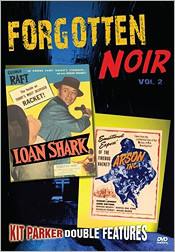 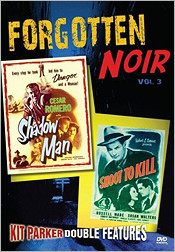 In Volume 2, the superior film is Loan Shark - a 1952 Lippert Pictures release starring George Raft. Raft was in his mid-50s by then and his film career was definitely on the down-turn although he continued to turn in professional efforts in each outing. Loan Shark finds him coming to live with his sister and brother-in-law just after coming out of prison. When his brother-in-law is murdered after bucking a loan sharking racket preying on workers at the local tire plant, Raft takes an undercover job there in an effort to expose the racket. The film has modest noir credentials in the form of some nice atmospheric lighting and in the nature of the Raft character's somewhat murky background, but otherwise it's a compact little thriller that holds attention throughout. With a natural acting style that adds credibility to his work, Raft is still be able to hold his own in the some of the rough stuff that the script calls for and as a result, he anchors the film strongly. Paul Stewart is, as usual, particularly effective as one of the racket's main frontmen. Arson Inc. (1949) is another matter. It's also a Lippert effort, this time starring frequent Lippert headliner Robert Lowery (also Batman in the 1949 Columbia serial). Unfortunately, the story (about an outfit that sets fires and arranges to collect the insurance) is mundane, lacking virtually any dramatic tension. The ending is a particular letdown. Meanwhile, Lowery is a bit of a wooden stick as an intrepid undercover agent for the Fire Department while Edward Brophy, much as I admire him in Damon Runyonesque gangster roles, does not have the menace needed to be the principal torchman. The video transfers are quite workmanlike using decent source material and offering a fairly sharp image with good shadow detail. Loan Shark is marginally the better of the two, particularly in the area of image detail. Speckles and some debris are evident from time to time on both. The transfer for Arson Inc. is listed as being from the original 35mm negative. Both offer mono sound that is adequately clear and subject to little hiss. There is a mediocre audio commentary accompanying Loan Shark by Richard Roberts that relies a bit too much on just describing what we can see for ourselves. Other supplements include trailers and the first part of a text essay on Lippert Pictures. Forgotten Noir Volume 3's superior entry is Shadow Man (1953), a modest but nicely atmospheric mystery with an amusement arcade background. It's quite reminiscent of the better titles in VCI's Hammer Film Noir series with its British setting and the use of an American star to boost box office (in this case, Cesar Romero). The film also costars Kay Kendall, but Victor Maddern steals the show as the disabled Limpy who manages Romero's arcade. VCI's source material is a print of the original British version known as Street of Shadows and running some seven minutes longer than the American theatrical release, courtesy of Lippert Pictures. Also included in Volume 3 is Shoot to Kill, a 1947 Screen Guild release starring Russell Wade and Susan Walters - about which the less said the better. The script is a contrived mess having something to do with a marriage between a beautiful woman (Susan Walters) and a D.A. gone bad (Edmund MacDonald). It appears that Walters agreed to the marriage in order to force MacDonald to redeem himself by cleaning up the town corruption. The story is told to a reporter, insipidly played by Russell Wade. Direction, if one could call it that, is by William Berke. As far as the DVD presentation is concerned, the better film Shadow Man appropriately fares best. It's looks very nice indeed, sporting a reasonably crisp image and good shadow detail. Shoot to Kill is much softer-looking and much more prone to dirt and debris. Audio on Shadow Man is quite acceptable, but on Shoot to Kill is subject to quite a bit of hiss and crackle. VCI has provided a nice collection of text-based supplements including a production schedule, script pages, and day player/stuntman contracts for Shoot to Kill; original theatrical trailers; and the second part of the essay on Lippert Pictures. VCI's efforts are sufficient to warrant a rental of both these discs for noir fans. 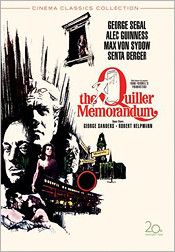 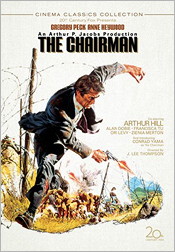 Spy movies became all the rage in the 1960s after the success of the first James Bond films in the early part of the decade. Fox has given us two nifty spy thrillers that were part of this cycle of films - The Quiller Memorandum and The Chairman. Based on the first of a series of books by Adam Hall, The Quiller Memorandum takes us to a divided Cold War Berlin where cynical agent Quiller (George Segal) is assigned by his control (Alec Guinness) to try to locate a shadowy group of Neo Nazis and their leader Oktober (Max Von Sydow). This is a film that delivers a diverting cat and mouse game without false heroics and one that holds interest throughout. It is very adept at conveying how much of the business of spying consists of the mundane while at the same time never letting us forget about the risk to life attendant to it. Building further upon a reputation at the time already well-established by his work in Who's Afraid of Virginia Woolf? and King Rat, George Segal is a stand-out as Quiller, the role of the sardonic, cynical Quiller being ideally suited to Segal's nature. Also effective is Senta Berger as a school teacher who seems to know more about the Neo Nazis than one might expect of a person in her profession. Von Sydow and Guinness play the sort of roles that have become well associated with them over the succeeding years. They are not lengthy in terms of screen time, but the portrayals are memorable nonetheless. The film benefits from not only an intelligent script with well-turned dialogue by Harold Pinter, but also location work in Berlin that went ahead despite some local uneasiness over the Neo Nazi theme. The Chairman takes us to the other side of the world as scientist Gregory Peck is recruited as a spy to travel to China where he will try to steal a formula that could solve the world's food problems. Accompanying him is a device implanted in his skull that allows him to be in contact with his control (Arthur Hill), but one that ultimately proves to be capable of much more than simply providing communications. The film has a different flavour from that of The Quiller Memorandum, offering as it does a more exotic and forbidding setting. The presence of Gregory Peck in the film's central role also adds a greater feel of a star-driven vehicle, although Peck's usual humanistic air means that it has much more in common with the real world of The Quiller Memorandum than that of the James Bond type of spy thriller. Building dramatic tension throughout, The Chairman ends in a burst of action that proves effective because of the lack of such action previously. Ironically the cover art emphasizes this action sequence, suggesting a type of film that it's not. Classic fans will be pleased to see Keye Luke of Charlie Chan fame playing a key (no pun intended) role in the film. Fox's DVD treatment is highly satisfactory. Both films have received fine 2.35:1 anamorphic transfers. Colours are bright and clean and the images look quite crisp. Grain is evident in both cases, but somewhat moreso on The Chairman. The latter also exhibits a little more debris and minor edge effects at times. The mono sound tracks are adequate to the tasks at hand. There is some minor hiss on The Chairman. Audio commentaries by Lee Pfeiffer of "Cinema retro" magazine and film historian Eddie Friedfeld are offered on both films. Both are very informative efforts entertainingly presented and giving both historical background as well as information on the film production. The Chairman disc also provides a 17-minute condensed version of the film as well as two scenes from the international release version that show a little more nudity than the American version. Both discs are recommended. 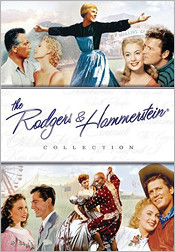 Staying with Fox, I'm pleased to report very positively on The Rodgers & Hammerstein Collection which boxes up last year's two-disc releases of Oklahoma!, State Fair, and The Sound of Music with new two-disc efforts for each of The King and I, Carousel, and South Pacific. The only caveat to my whole-hearted endorsement of this offering is the observation that the shortcomings of last year's Oklahoma! release (the poor Todd-AO version) have not been addressed. All six films are presented in slim cases in the new collection. Of the three new films, The King and I and Carousel are designated 50th Anniversary Editions while South Pacific is called the Collector's Edition. Each is also available separately. The King and I sports a superb 2.55:1 anamorphic transfer offering a sharp clean image that is virtually free of any dirt or debris, colours that appear spot on, and no sign of annoying edge effects. The 5.0 Dolby audio track offers good separation and some nice subtle surround effects (a stereo track is also included). Among the supplements are an audio commentary by film scholar Richard Barrios and musical theatre historian Michael Portantiere, isolated musical score and songs only options, an Anna and the King TV pilot with commentary by Samantha Eggar, six making-of featurettes, and various other vintage material. Carousel offers a 2.55 anamorphic transfer and 5.0 Dolby track that are equally as good as those of The King and I. The nature and range of the supplements is comparable, including notably the 1934 film Liliom (Carousel is a musicalized version of Ferenc Molnar's fantasy "Liliom"). (It should be noted that many of us were hoping that it was the 1930 Frank Borzage version that would be included, as Fritz Lang's 1934 Liliom is already available from Kino. That was not to be, but Fox's transfer of the 1934 Liliom looks sharper and better detailed than Kino's at least.) Finally, South Pacific is presented in a 2.20:1 anamorphic transfer that also looks quite sharp although perhaps not quite as vibrant as the efforts on The King and I and Carousel. I've never been a big fan of the colour tints that characterize the film, but at least they appear to be presented properly here. The second disc includes the "road show" version of the film incorporating some 15 additional minutes which predictably don't look quite as good as the rest. Both versions of the film have their own audio commentaries (by Rodgers & Hammerstein Organization president Ted Chapin and musical theatre writer Gerard Alessandrini on the standard release, and by film scholar Richard Barrios on the extended version). Others supplements include an hour-long TV show in which author James Michener (upon whose stories the musical is based) returns to the South Pacific with Diane Sawyer, a songs-only option, and various vintage material. 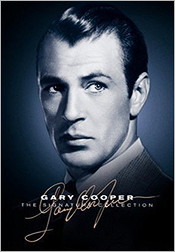 There's virtually always something new from Warner Bros. to report on and this outing is no exception. I start off with Gary Cooper: The Signature Collection. Cooper working at Paramount and with Samuel Goldwyn for much of the early part of his career, but in 1947, he signed a long-term contract with Warner Bros. His first and best picture under the deal would be The Fountainhead; successive films would be formulaic and lead to Cooper dropping out of the list of top-ten box office performers in 1951. Gary Cooper: The Signature Collection includes The Fountainhead and two westerns from this Warner period (Dallas and Springfield Rifle), and brackets them with Cooper's Academy Award role in Sergeant York (made for Warners in 1941 when he was freelancing) and The Wreck of the Mary Deare (made by his own company Baroda Productions for MGM in 1959). Only The Fountainhead and Sergeant York are also available separately from the set. Sergeant York is a two-disc effort and it is clearly the class of the set as both a film and as a DVD presentation. The Howard Hawks-directed film works successfully as both a backwoods saga despite the clichés of the script (the first half that provides the background to Alvin Woods position as a pacifist) and army and battlefront drama (the second half that documents the events leading to York's Congressional Medal of Honor). Cooper always shone best in roles that fit his taciturn nature closely and this was one of the best examples. He receives excellent support from Walter Brennan and Margaret Wycherly, as well as a number of the Warner stock company including Joan Leslie, Stanley Ridges, and George Tobias. The film was a tremendous success at the box office and eventually was recognized as one of Hollywood's most potent wartime propaganda films. The DVD presentation is very nice. The image is generally quite sharp with a very good gray scale in evidence. There are, however, some scratches and a few speckles clearly present. The mono sound is in good shape. Among the supplements are an excellent audio commentary by Jeanine Basinger, a new making-of featurette, a vintage profile on Gary Cooper, a vintage short and the cartoon Porky's Preview, and a Gary Cooper trailer gallery. The Fountainhead is the other title that receives special attention in the set. It's a single disc presentation that includes a new making-of featurette. The film itself is based on Ayn Rand's book of the same title and benefits from a screenplay by her. The story concerns architect Howard Roark (Cooper) who has definite ideas about building design that set him far apart from the architectural establishment. He will sacrifice anything - the woman he loves (Patricia Neal) or a building project based on his designs that becomes compromised - to maintain his individuality. The film has an individualistic style that reflects its lead character, reflected particularly in its somewhat awkward dialogue and distinctive art direction. Both Cooper and Neal give performances that really stick in one's mind. Copper's seems to me one of his best efforts as he exhibits more in-your-face emotion than usual. Neal's work is also compelling even though her efforts are less subtle than one would like in order to be most effective. Raymond Massey is also noteworthy as the newspaper publisher who plays a key role in Roark's life. The film is no masterpiece, but it is different and has repeat-viewing potential. The image transfer is the best in the set, offering a crisp clear image with excellent contrast and very nice image detail. Warners made some of the best big-scale westerns of the 1940s, but they seemed to lose luster in the 1950s. As a general rule of thumb, Fox, Columbia, and Universal all were better bets for westerns in that decade. Dallas and Springfield Rifle have little to recommend them other than good colour and Max Steiner's musical scores (particularly Dallas, in the latter instance). The production polish is there, but the stories are uninteresting and executed perfunctorily, as though Warners was turning them out in its sleep. Andre De Toth is at the directorial helm of Springfield Rifle which lends it a little more interest in terms of framing and the execution of action sequences. Generally, Cooper looks rather bored with whole business. Both films have decent DVD presentations, full frame as originally presented. The colours are bright and reasonably accurate. There is some dirt and debris, but it's not distracting. The mono sound is unremarkable and here are no supplements. A much better film rounds out the set - The Wreck of the Mary Deare. It's based on the thriller by Hammond Innes and has a fine screenplay by Eric Ambler. Cooper plays Gideon Patch, the first officer of a sinking ship whose captain is dead and whose crew has abandoned her. With the help of a salvage boat seaman (Charlton Heston), Patch manages to ground the ship safely and the two agree to keep the ship's whereabouts a secret until a court of inquiry can be convened at which Patch hopes to have the circumstances of the doomed ship and his role in them fully aired. This is a lesser-known Cooper film that deserves attention. It's a fine suspense story and mystery that maintains interest throughout, blending some fine shipboard footage with well-staged underwater sequences and courtroom scenes. Along with The Hanging Tree and Man of the West, it contains some of Cooper's best late-career work. Heston is well cast opposite Cooper and the two interact effectively. Richard Harris has a good if obvious supporting part. The 2.35:1 anamorphic transfer is very good, capturing the difficult dimly-lit shipboard scenes equally as well as the courtroom interiors. Image detail is very good and the colour seems quite natural although skin tones may be off slightly. The mono sound is clear and robust. There are no supplements. The film offers good ammunition for buying the set as it's not available otherwise. Gary Cooper: The Signature Collection is recommended.  Warners' Motion Picture Masterpieces has been out for a couple of months now and I've thoroughly enjoyed viewing each of the five MGM- produced films in it - David Copperfield, A Tale of Two Cities, Treasure Island, Marie Antoinette, and Pride and Prejudice. Of course, I've seen them all several times in the past, but none have looked as good as they do now in this new set. David Copperfield and A Tale of Two Cities have been particularly problematic on past home video incarnations, so Warners' restoration efforts are most welcome for them. Both of those two films, made in the mid-1930s are the result of producer David O. Selznick's efforts at MGM before he left to form his own production company and both remain the definitive film versions of the Dickens classics, despite numerous TV filmizations since. David Copperfield is a particularly faithful and at 131 minutes an amazingly complete version. One might wish for more of the Steerforth strand of the story, but otherwise it's hard to quibble. The main characterizations are all vividly drawn, particularly Freddie Bartholomew as the young Copperfield, Basil Rathbone as Mr. Murdstone, Lionel Barrymore as Dan Peggotty, Jessie Ralph as Nurse Peggotty, Edna May Oliver as Betsy Trotwood, and W.C. Fields as Mr. Micawber, but the many secondary and fringe characters are also memorable. Even a main character such as Uriah Heap is memorably played by Roland Young although he makes the character a little too insipid for my liking. Director George Cukor does an amazing job at orchestrating the whole thing although one knows Selznick is also due a great deal of the credit too. A Tale of Two Cities at just over two hours in length also manages to cram in an amazing amount of Dickens' densely-plotted novel. Were there nothing else of note in the film but Ronald Colman's intonation of Sydney Carton's famous words ("It is a far, far better thing I do now than I have ever done. It is a far, far better rest I go to than I have ever known."), the film would still be a success. Fortunately, that's merely the icing on another cake of excellent characterizations and gripping story-telling, this time directed by Jack Conway. As with David Copperfield, the film is another cornucopia of Hollywood character actors, drawing particularly from the colony of British players. By the end of the 1930s, MGM no longer had the production team of Irving Thalberg and David Selznick and the height of the studio's glory days, aside from musicals, was slipping behind it. It still, however, could turn out the occasional gem based on classic material as the 1940 production of Jane Austen's Pride and Prejudice amply proved. Greer Garson plays Elizabeth Bennet, the eldest of five sisters all vying to get married. The object of her interest is Mr. Darcy (Laurence Olivier) whose initial behaviour seems to make him an unsatisfactory choice despite his undeniable physical attractiveness. Casting is once again superb and the typical MGM production gloss is very much in evidence. The film's pace is leisurely, but the script is full of bon mots and one is quickly drawn into the plot machinations even though one knows the inevitable outcome. Both Garson and Olivier fit their roles well and Mary Boland is particularly pleasing as the scheming Mrs. Bennet. One perhaps doesn't always think of Treasure Island as one of the classics, but it is nevertheless, as written by Robert Louis Stevenson. The 1934 MGM production reunited the two stars of 1931's The Champ - Wallace Beery and Jackie Cooper - as Long John Silver and young Jim Hawkins, both sailing on the ship Hispaniola as they search for hidden pirate treasure. The original novel is particularly successful in conjuring up vivid images in one's mind of both unusual characters and exotic or at least offbeat places, and the film succeeds in matching one's imagination very well. The story is timeless and one is quickly immersed in Jim Hawkins' fate. Both Beery and Cooper are well cast. Marie Antoinette is the only film in the bunch lacking a classic novel as its source material. Yet it fits the package well by virtue of its subject matter and temporal setting. Norma Shearer plays the title role in the 1938 film, with Tyrone Power as her co-star and character's ardent lover. John Barrymore and Robert Morley portray Louis XV and XVI respectively while the usual plethora of Hollywood character actors (e.g. Joseph Schildkraut, Gladys George, Henry Stephenson, ably provide support Those unfamiliar with Norma Shearer's capabilities will find Marie Antoinette to be a good indicator. She plays her part with conviction throughout and she is particularly affecting portraying Marie Antoinette's final days. As for the production as a whole, if there is a single word to describe the film, it would be "lavish", particularly insofar as the costuming and set decoration are concerned. They aptly fit the excesses of the actual era. Warner Bros. presents each film in the set on a separate disc and in a regular keep case. Each title may also be purchased separately. Marie Antoinette fares best in terms of image as it offers a clean mostly crisp transfer with minimal speckling or debris. Pride and Prejudice and A Tale of Two Cities are also both quite nice looking with very good contrast and minor amounts of grain. David Copperfield and Treasure Island have the weakest of the set's transfers with noticeable speckling and scratches and a sometimes soft image. Still both offer substantial improvement over any previous home video incarnations. The mono sound on all is quite acceptable although the earlier films have some minor background hiss. Each disc provides a nice package of supplements typical to many Warner releases - two or three shorts/cartoons (several in Technicolor), the theatrical trailer, and some audio-only material in a couple of instances. Very highly recommended. |
on to Page Two
 |
| Site
designed for 1024 x 768 resolution, using 16M colors and .gif 89a
animation. © 1997-2015 The Digital Bits, Inc., All Rights Reserved. billhunt@thedigitalbits.com |